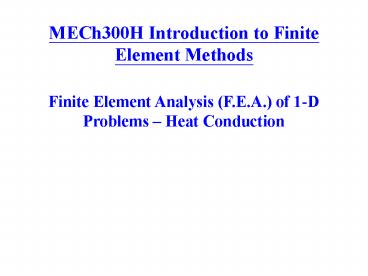MECh300H Introduction to Finite Element Methods PowerPoint PPT Presentation
Title: MECh300H Introduction to Finite Element Methods
1
MECh300H Introduction to Finite Element Methods
Finite Element Analysis (F.E.A.) of 1-D Problems
Heat Conduction
2
Heat Transfer Mechanisms
- Conduction heat transfer by molecular
agitation within a material without any motion of
the material as a whole. - Convection heat transfer by motion of a fluid.
- Radiation the exchange of thermal radiation
between two or more bodies. Thermal radiation is
the energy emitted from hot surfaces as
electromagnetic waves.
3
Heat Conduction in 1-D
Heat flux q heat transferred per unit area per
unit time (W/m2)
Governing equation
Q heat generated per unit volume per unit time
C mass heat capacity
k thermal conductivity
Steady state equation
4
Thermal Convection
Newtons Law of Cooling
5
Thermal Conduction in 1-D
Boundary conditions
Dirichlet BC
Natural BC
Mixed BC
6
Weak Formulation of 1-D Heat Conduction(Steady
State Analysis)
- Governing Equation of 1-D Heat Conduction -----
0ltxltL
- Weighted Integral Formulation -----
- Weak Form from Integration-by-Parts -----
7
Formulation for 1-D Linear Element
Let
8
Formulation for 1-D Linear Element
Let w(x) fi (x), i 1, 2
9
Element Equations of 1-D Linear Element
10
1-D Heat Conduction - Example
A composite wall consists of three materials, as
shown in the figure below. The inside wall
temperature is 200oC and the outside air
temperature is 50oC with a convection coefficient
of h 10 W(m2.K). Find the temperature along the
composite wall.
t3
t2
t1
x
11
Thermal Conduction and Convection- Fin
Objective to enhance heat transfer
Governing equation for 1-D heat transfer in thin
fin
w
t
x
dx
where
12
Fin - Weak Formulation(Steady State Analysis)
- Governing Equation of 1-D Heat Conduction -----
0ltxltL
- Weighted Integral Formulation -----
- Weak Form from Integration-by-Parts -----
13
Formulation for 1-D Linear Element
Let w(x) fi (x), i 1, 2
14
Element Equations of 1-D Linear Element
PowerShow.com is a leading presentation sharing website. It has millions of presentations already uploaded and available with 1,000s more being uploaded by its users every day. Whatever your area of interest, here you’ll be able to find and view presentations you’ll love and possibly download. And, best of all, it is completely free and easy to use.
You might even have a presentation you’d like to share with others. If so, just upload it to PowerShow.com. We’ll convert it to an HTML5 slideshow that includes all the media types you’ve already added: audio, video, music, pictures, animations and transition effects. Then you can share it with your target audience as well as PowerShow.com’s millions of monthly visitors. And, again, it’s all free.
About the Developers
PowerShow.com is brought to you by CrystalGraphics, the award-winning developer and market-leading publisher of rich-media enhancement products for presentations. Our product offerings include millions of PowerPoint templates, diagrams, animated 3D characters and more.

